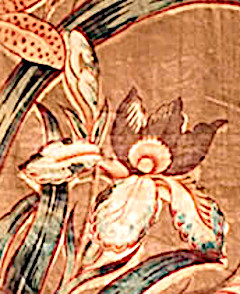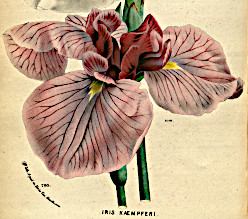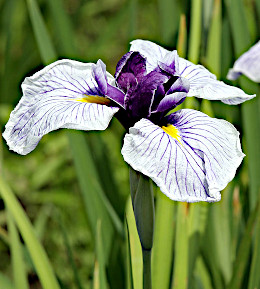Floral Motifs on Early Chintz
Iris ensata (Japanese Water Iris)



Iris ensata (Japanese Water Iris) (published as Iris kaempferi) from Louis van Houtte, Flore des serres et des jardin de l’Europe, vol. 20, unnumbered illustration preceeding p. 45, 1874
Iris ensata (Japanese Water Iris) from the Charleston Museum John Lowe & Company of Shepley Hall Chintz Fragment, dated 1835. Image courtesy of the Charleston Museum, Charleston, SC.
Iris ensata (Japanese Water Iris) Photo by Laitche [CC BY-SA (https://creativecommons.org/licenses/by-sa/3.0)]
Common Names: Japanese Water Iris, Japanese Iris
Description: Iris ensata (Japanese Water Iris) is a member of the Iris Family (Iridaceae). Iris ensata (formerly Iris kaempferi) this native of Japan, China, Korea, and Russia and was introduced to European cultivation about the mid-19th century.* This identification is tentative because the date of the chintz fragment appears to preceed introduction of the plant to European cultivation. The chintz design may have been based on an early unidentified botanical illustration, an imported Japanese porcelain or painting, or may have been based on an unidentified closely related Iris in the subgenus Limniris. However the similarity of the chintz design to Iris ensata is striking.
Quilts with this Iris ensata (Japanese Water Iris) motif:
Chintz with this Iris ensata (Japanese Water Iris) motif:
*"Iris ensata," Wikipedia, 9 December 2019, https://en.wikipedia.org/wiki/Iris_ensata; accessed January 27, 2020.
© Updated 2/2/2020 Author: Terry Terrell
Description: Iris ensata (Japanese Water Iris) is a member of the Iris Family (Iridaceae). Iris ensata (formerly Iris kaempferi) this native of Japan, China, Korea, and Russia and was introduced to European cultivation about the mid-19th century.* This identification is tentative because the date of the chintz fragment appears to preceed introduction of the plant to European cultivation. The chintz design may have been based on an early unidentified botanical illustration, an imported Japanese porcelain or painting, or may have been based on an unidentified closely related Iris in the subgenus Limniris. However the similarity of the chintz design to Iris ensata is striking.
Quilts with this Iris ensata (Japanese Water Iris) motif:
- None known at this time
Chintz with this Iris ensata (Japanese Water Iris) motif:
- The Charleston Museum, The John Lowe & Company of Shepley Hall Chintz Fragment, Shelving Locator HT 572, dated 1835
*"Iris ensata," Wikipedia, 9 December 2019, https://en.wikipedia.org/wiki/Iris_ensata; accessed January 27, 2020.
© Updated 2/2/2020 Author: Terry Terrell